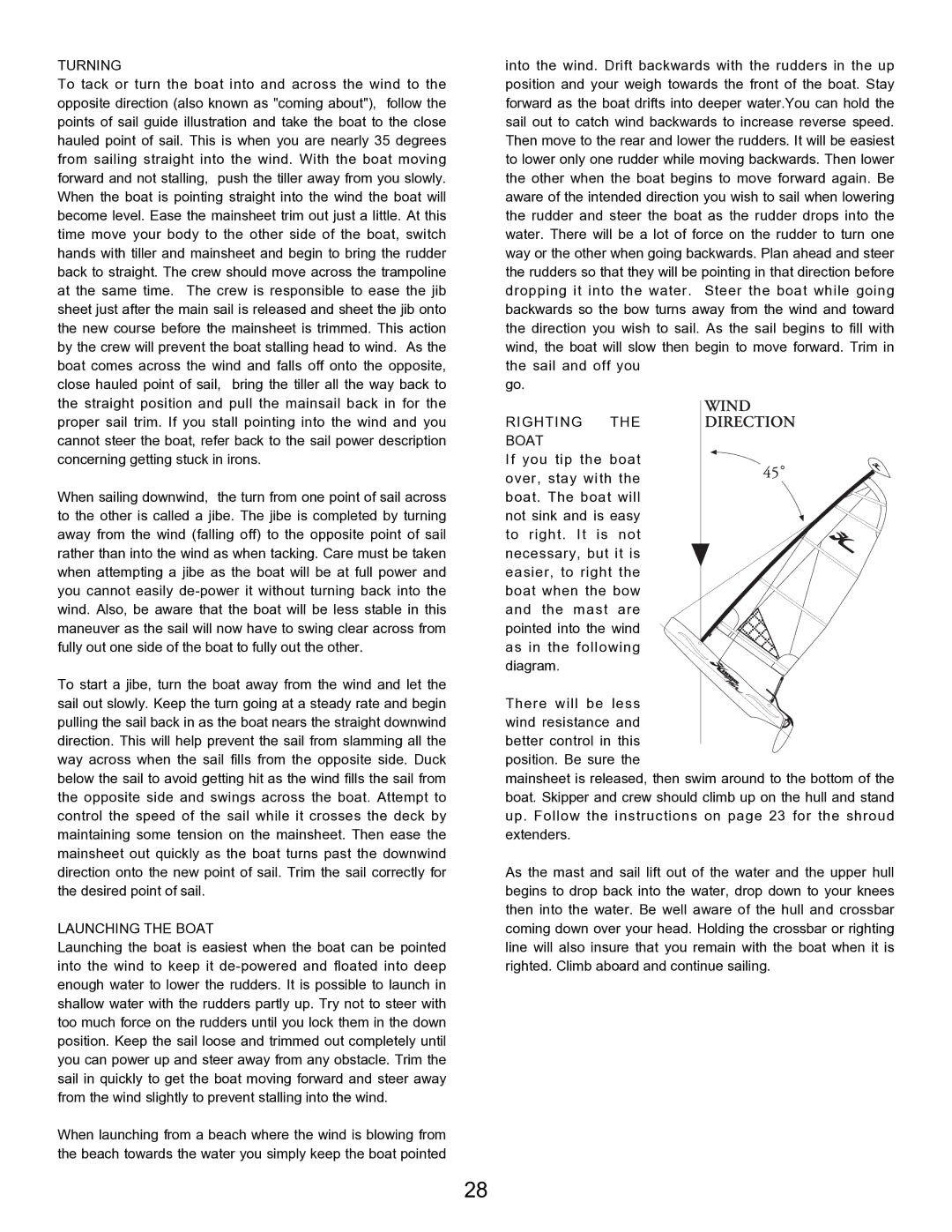
TURNING
To tack or turn the boat into and across the wind to the opposite direction (also known as "coming about"), follow the points of sail guide illustration and take the boat to the close hauled point of sail. This is when you are nearly 35 degrees from sailing straight into the wind. With the boat moving forward and not stalling, push the tiller away from you slowly. When the boat is pointing straight into the wind the boat will become level. Ease the mainsheet trim out just a little. At this time move your body to the other side of the boat, switch hands with tiller and mainsheet and begin to bring the rudder back to straight. The crew should move across the trampoline at the same time. The crew is responsible to ease the jib sheet just after the main sail is released and sheet the jib onto the new course before the mainsheet is trimmed. This action by the crew will prevent the boat stalling head to wind. As the boat comes across the wind and falls off onto the opposite, close hauled point of sail, bring the tiller all the way back to the straight position and pull the mainsail back in for the proper sail trim. If you stall pointing into the wind and you cannot steer the boat, refer back to the sail power description concerning getting stuck in irons.
When sailing downwind, the turn from one point of sail across to the other is called a jibe. The jibe is completed by turning away from the wind (falling off) to the opposite point of sail rather than into the wind as when tacking. Care must be taken when attempting a jibe as the boat will be at full power and you cannot easily
To start a jibe, turn the boat away from the wind and let the sail out slowly. Keep the turn going at a steady rate and begin pulling the sail back in as the boat nears the straight downwind direction. This will help prevent the sail from slamming all the way across when the sail fills from the opposite side. Duck below the sail to avoid getting hit as the wind fills the sail from the opposite side and swings across the boat. Attempt to control the speed of the sail while it crosses the deck by maintaining some tension on the mainsheet. Then ease the mainsheet out quickly as the boat turns past the downwind direction onto the new point of sail. Trim the sail correctly for the desired point of sail.
LAUNCHING THE BOAT
Launching the boat is easiest when the boat can be pointed into the wind to keep it
When launching from a beach where the wind is blowing from the beach towards the water you simply keep the boat pointed
into the wind. Drift backwards with the rudders in the up position and your weigh towards the front of the boat. Stay forward as the boat drifts into deeper water.You can hold the sail out to catch wind backwards to increase reverse speed. Then move to the rear and lower the rudders. It will be easiest to lower only one rudder while moving backwards. Then lower the other when the boat begins to move forward again. Be aware of the intended direction you wish to sail when lowering the rudder and steer the boat as the rudder drops into the water. There will be a lot of force on the rudder to turn one way or the other when going backwards. Plan ahead and steer the rudders so that they will be pointing in that direction before dropping it into the water. Steer the boat while going backwards so the bow turns away from the wind and toward the direction you wish to sail. As the sail begins to fill with wind, the boat will slow then begin to move forward. Trim in the sail and off you
go.
RIGHTING THE BOAT
If you tip the boat over, stay with the boat. The boat will not sink and is easy to right. It is not necessary, but it is easier, to right the boat when the bow and the mast are pointed into the wind as in the following diagram.
There will be less wind resistance and better control in this
position. Be sure the
mainsheet is released, then swim around to the bottom of the boat. Skipper and crew should climb up on the hull and stand up. Follow the instructions on page 23 for the shroud extenders.
As the mast and sail lift out of the water and the upper hull begins to drop back into the water, drop down to your knees then into the water. Be well aware of the hull and crossbar coming down over your head. Holding the crossbar or righting line will also insure that you remain with the boat when it is righted. Climb aboard and continue sailing.
28
